It has been a while since I had last cooked a recipe from Biba Caggiano, my favorite cookbook author. Rabbit in piquant sauce is something I had prepared before more than a decade ago, and I remember the rabbit turned out a bit dry and tough. I thought it would be worth trying it again, and decided to make it both as a traditional stovetop braise (as per Biba’s recipe) as well as a sous-vide version. Both recipes are included below. The piquant sauce with tomatoes, vinegar, garlic, anchovy, rosemary, capers, and parsley is delicious and has great depth of flavor. Although it is great with farmed rabbit, I am sure it was originally intended to mask the strong scent that wild (feral) rabbit meat often has. The main change I made to Biba’s recipe is that I prefer to mince the capers rather than including them whole.
Rabbit meat is notoriously difficult to cook right. As the meat is so lean, it will easily get dry before it becomes tender. Even sous-vide it is difficult, as rabbit can become unpleasantly tender. You may not believe that meat could ever become too tender, but way until you try rabbit cooked sous-vide for too long at 60C/140F. When cooked just for a couple of hours at that temperature, the rabbit becomes amazing and unlike anything you could achieve on a stovetop. But you may not like that texture, as it is unlike what you are used to.
I recently read about cooking rabbit sous-vide for 8 hours at 75C/167F. At first I thought that couldn’t possibly work. If rabbit is already overcooked after 5 hours at 60C/140F, surely it would be extremely overcooked when cooked both longer and hotter. It turned out I was wrong. Rabbit cooked sous-vide for 8 hours at 75C/167F is exactly like a stovetop braise in terms of texture and tenderness. It is not as juicy as cooked sous-vide for a couple of hours at 60C/140F, but it certainly isn’t dry either. And the good thing is, compared to the stovetop braise it is easier and fool-proof. Even a talented and experience cook like ChgoJohn mentioned that he once messed up cooking a rabbit, and I certainly have, too.(As a coincidence, ChgoJohn blogged about a great recipe for stovetop braised rabbit today as well. Go check out his great blog if you don’t know it already.) So from now on, I will be cooking rabbit sous-vide for 8 hours at 75C/167F for consistent results.
Below I start with the stovetop recipe, followed by the sous-vide version. The ingredients are the same for both versions, but the preparation is a bit different as in the sous-vide version sauce and meat have to be cooked separately. The meat is cooked sous-vide in the sauce, but the sauce itself isn’t reduced or actually cooked during the sous-vide process.
Ingredients
For 2 servings
2 rabbit legs, about 400 grams (.9 lb) total
2 Tbsp olive oil
1 garlic clove, minced
1/2 Tbsp minced fresh rosemary
salt and freshly ground black pepper
80 ml (1/3 cup) dry white wine
120 ml (1/2 cup) pureed canned plum tomatoes
60 ml (1/4 cup) good-quality white wine vinegar
1 anchovy fillet, minced, or an equivalent amount of anchovy paste
1/2 Tbsp minced fresh flat leaf parsley leaves
1 Tbsp rinsed, dried and minced capers
Stovetop preparation
(Scroll down for the sous-vide preparation.)
Heat 2 Tbsp of olive oil in a frying pan. Brown the rabbit pieces on all sides over medium heat.
When the rabbit pieces have been browned, season with salt and freshly ground black pepper on both sides, and add garlic and rosemary.
Add 80 ml (1/3 cup) of dry white wine, and stir over medium heat until half of it has evaporated.
Add 120 ml (1/2 cup) of pureed canned tomatoes.
Bring to a boil, then reduce the heat to a simmer.
Cover and simmer over very low heat for about an hour and a half, or until the rabbit is tender. (Biba says 30 to 40 minutes, but in my experience that is never enough to get it tender.)

Stir and turn the rabbit legs about every 15-20 minutes.
In a small saucepan, cook 60 ml (1/4 cup) white wine vinegar…
…until reduced to about a tablespoon. Turn off the heat.
Mince 1 anchovy fillet with a tablespoon of capers and half a tablespoon of parsley.
Add this mixture to the vinegar.
When the rabbit is tender, take it out of the pan and put it on preheated plates.
Add the vinegar mixture to the pan.
Cook over high heat, stirring, until the sauce has has a nice thick consistency.
Serve the rabbit with the sauce. (In this case I served it with oven-roasted potatoes and peperonata on the side.)
Sous-vide Preparation
Season the rabbit legs with salt and freshly ground black pepper. Brown them in olive oil on all sides. Tilt the pan to brown them on the sides as well, as shown in the photo.
When the rabbit legs have been browned, take them out of the pan and put them on a plate to cool. Add half a tablespoon of minced rosemary and a minced garlic clove to the pan, and stir for a few seconds (making sure the garlic doesn’t brown, as that would make it bitter).
Deglaze with 80 ml (1/3 cup) of dry white wine.
Cook over medium heat, scraping with a wooden spatula to get any browned bits into the sauce, until the wine has been reduced by about half.
Add 120 ml (1/2 cup) of pureed canned tomatoes.
Cook over medium heat, stirring regularly, while the rabbit legs are still cooling off.
Keep going until the sauce has a nice thick consistency. Remember that the sauce won’t reduce when it is cooked sous-vide in a vacuum sealed bag!
The rabbit with sauce cannot be vacuum sealed using a regular ‘clamp’ vacuum sealer.
If you have a chamber vacuum sealer, allow both the rabbit and the sauce to cool off completely, then vacuum seal. (When they have not cooled off, the low pressure will make the juices boil at a low temperature.)
If not, use a ziplock bag and the water displacement method. In that case, it is fine if the rabbit and/or sauce are still warm.
Cook sous-vide for 8 hours at 75C/167F.
After those 8 hours, pour the sauce from the bag into a frying pan and add 60 ml (1/4 cup) of white wine vinegar.
Cook over medium heat until the sauce has a nice thick consistency.
Put the rabbit legs in the pan as well, and add half a tablespoon of minced parsley, a minced anchovy fillet, and a tablespoon of minced capers. Stir to incorporate those into the sauce, and cook over low heat until the rabbit legs have warmed up a little on the outside (if you like you could coat them with the sauce).
Serve the rabbit with the sauce on preheated plates. (In this case I served it with oven-roasted potatoes and peperonata on the side.)
Wine pairing
This is nice with a Zweigelt, a spicy but light bodied red from Austria.
Flashback
By coincidence, today’s flashback is also one of Biba’s recipes: stuffed veal bundles.







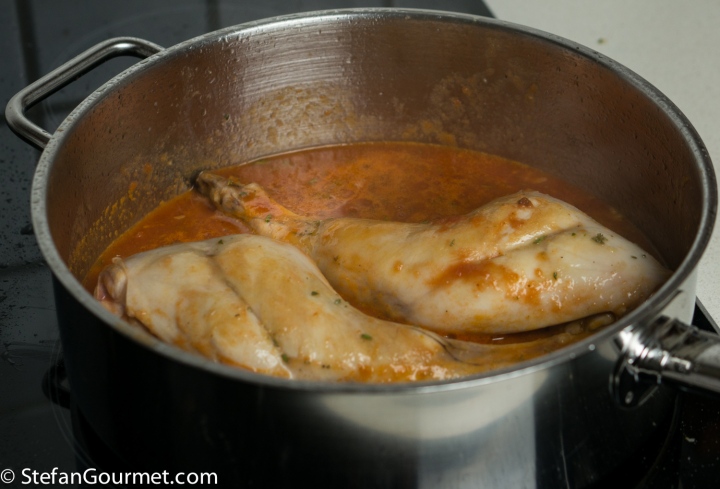
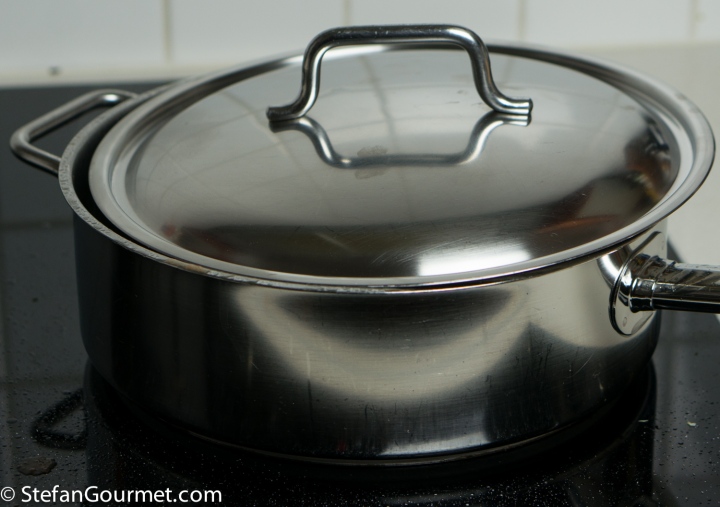
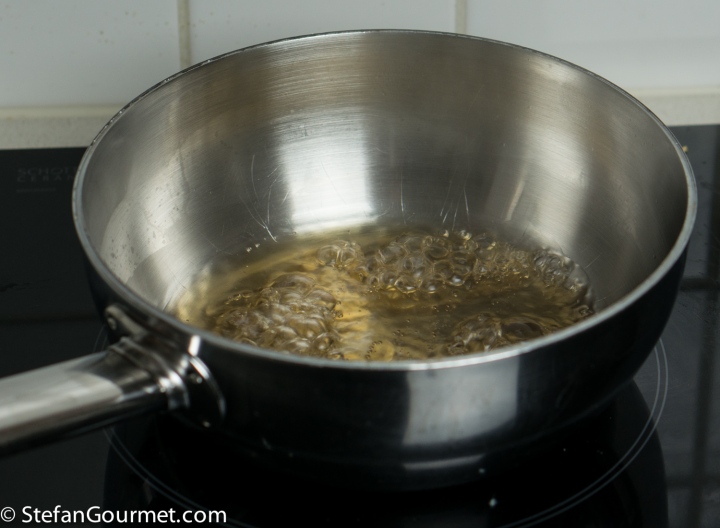


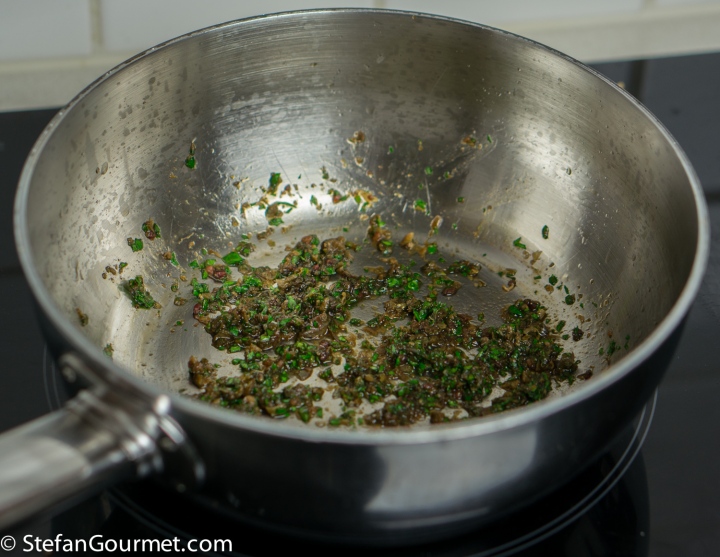
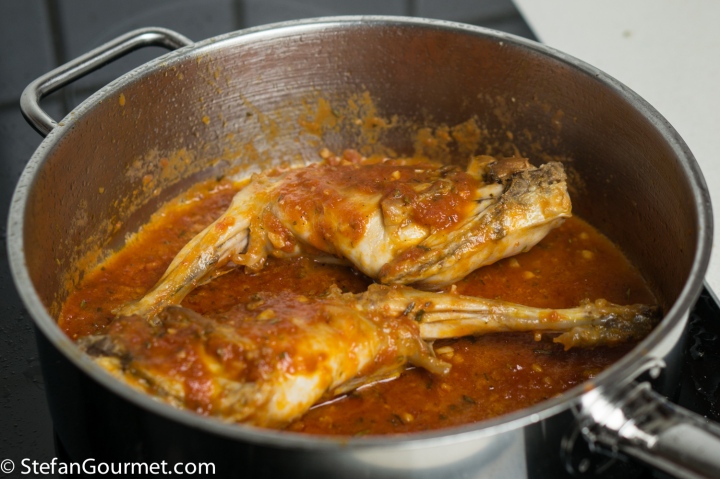

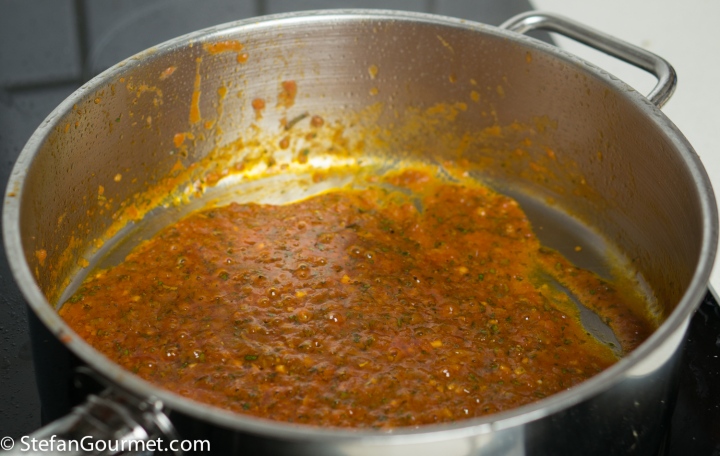

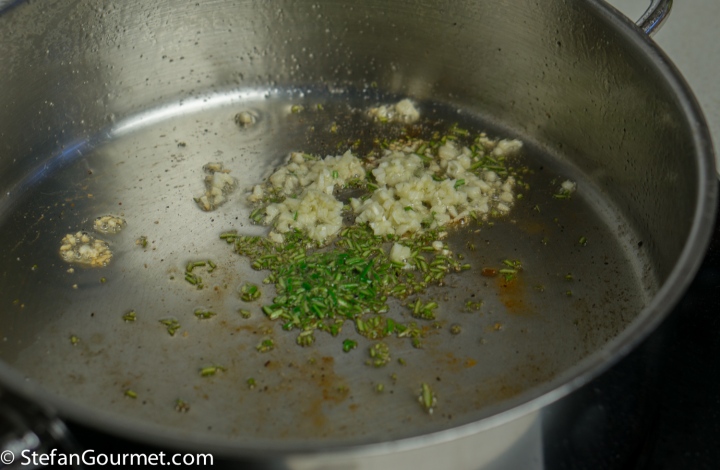
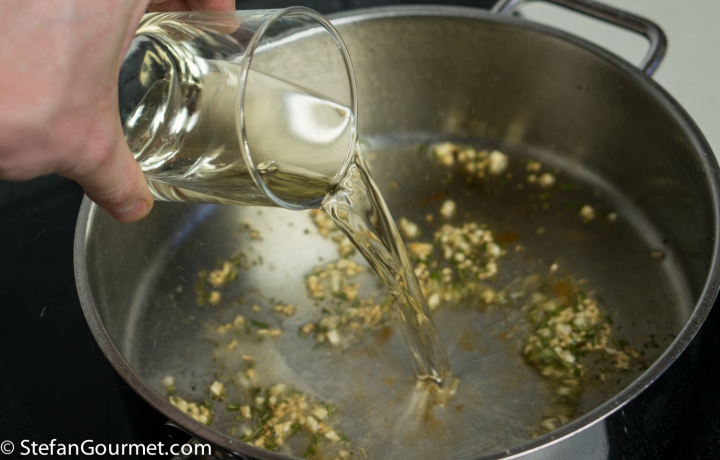

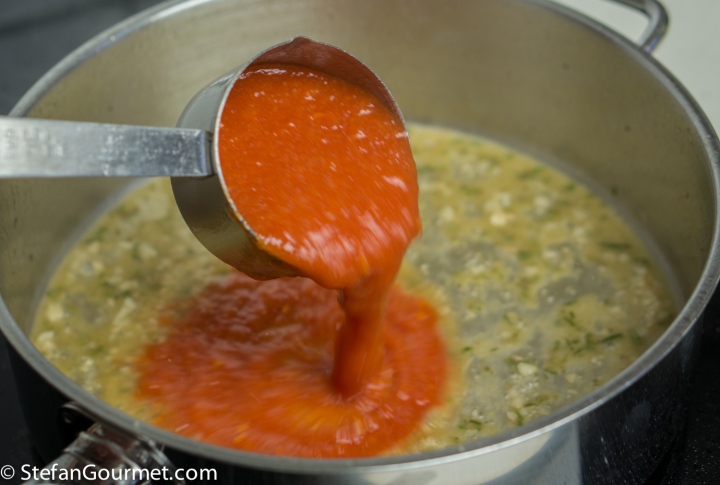

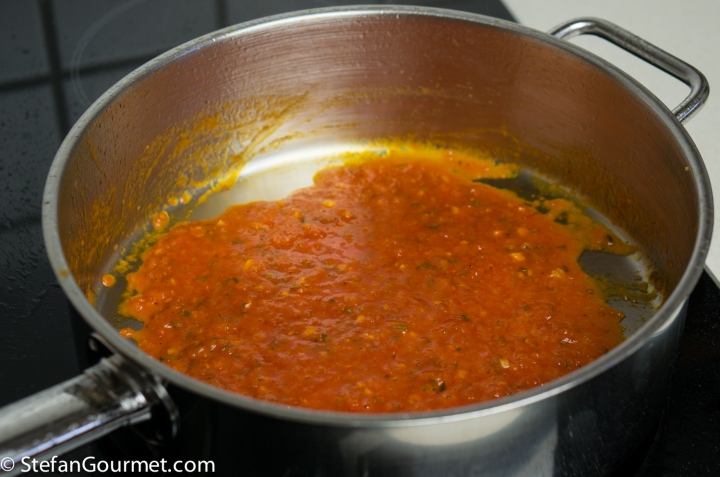
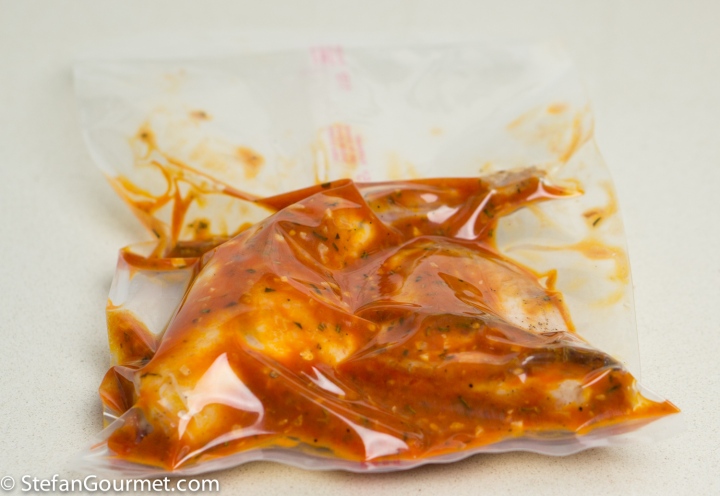






Ho un bel coniglio in freezer, prenderò spunto!
LikeLiked by 1 person
Great recipe but sad fact: one has to have quality produce to begin with – don’t think I have ever seen such ‘luscious’ rabbit legs here . . . 😦 !!
LikeLiked by 1 person
And I’d say you do have plenty of rabbits. But then again, I remember kangaroo meat was located next to dog food at the Woolies.
LikeLiked by 1 person
Thanks for the laugh!! It still IS next to the pet meats at Woolies, so are oxtail, chicken livers, tripe and a few other ‘goodies’: we all hope they stay there ’cause that is the cheap aisle !!! When beef cheeks ‘moved’ – they tripled in price 🙂 !!
LikeLiked by 1 person
Beautifully composed plate. The anchovies/capers addition in the recipe sounds divine.
LikeLiked by 1 person
I am a follower of ChgoJohn and saw in his comments that you had just made rabbit too! The sauce for this sounds so rich and delicious. I also really like your side-by-side comparisons, I hope you keep doing them!
LikeLiked by 2 people
I’ll take the 8 hour version in this case, thanks. Sounds delicious.
LikeLiked by 1 person
You already know my rabbit story. 😀 )))
LikeLiked by 1 person
What exactly are the two methods of sealing (sous vide) What is chamber? I have a vacuum sealer. What should I do? Thank you
LikeLike
Hi Diane,
There are three types of vacuum sealing for sous-vide cooking, and two types of vacuum sealers.
The most common type of vacuum sealer is a ‘clamp’ style vacuum sealer. You only put the end of the bag inside the sealer, and then the sealer will suck the air out of the bag and then seal. A common brand name is the FoodSaver. This type of vacuum sealing is not suitable for this recipe, because it would suck the sauce out of the bag.
A chamber vacuum sealer has a chamber in which you place the bag. So the entire bag sits inside the vacuum sealer, not just the top. This type of vacuum sealing is suitable for recipes with fluids in the bag.
Finally, you can ‘vacuum seal’ (not really a vacuum but close enough so the bag won’t float) by using a ziplock bag and submerging that to push the air out, and then sealing before any water enters the bag. This is called the water displacement method and is a trick to be able to seal a bag with fluids even if you do not own a chamber vacuum sealer.
Hope this helps!
Stefan
LikeLike
could I just seal both ends? I really would like to make this
LikeLike
Sorry, Stefan. I thought I had replied to this comment when it first appeared …
Thank you for sharing your spotlight and mentioning our family recipe. (Did you have to mention my screw up? 🙂 )
I like your stovetop method and maybe I’ll try it the next time Zia and I are together. I won’t be able to find rabbit legs but surely a whole rabbit will work just as well. Now that my neighborhood butcher closed, I have to find another for “exotic” meats. How ever did rabbit become “exotic”? Oh, brave new world!
LikeLiked by 1 person
It won’t be long until anything that still remotely reminds us of an animal will become ‘exotic’, I’m afraid.
You could (and should!) read the part about your screw up as a compliment!
LikeLiked by 1 person
thanks for the inspiration Stefan! I am making a favorite recipe from Paula Wolfert’s
The Cooking of Southwest France.. (many favorites there): Compote of Rabbit with Prunes. I do not like picking out all the little bones from the cut up rabbit so I thought it would be good to cook the whole rabbit sous vide, instead of braising in the oven.
I do have a chamber type vacuum sealer but not a very deep one, so I froze the mix before sealing. I assume that someone wanting to try your recipe who had a food-saver type of sealer could also seal the bag with liquid as long as it is frozen.
LikeLike
Ciao stefan
I have onr question: is there an explanation why cooking the rabbit l(much) longer and at a higher temperature, the meat is better and it is not obercooked? Any thought? Thanks, ciao stefano
LikeLike
Hi Stefano, I do not understand this process completely (yet), but I think it has something to do with the fact that two things will happen when you heat meat: (1) the proteins will shorten, and (2) the proteins will soften. At a higher heat, (1) will happen a lot more and quickly. Once that is happened (and the meat has become flaky), the softening has a different effect. If you cook the rabbit at 60C it will become soft without becoming flaky. I hope this makes any sense?
LikeLike